In what may be the most important announcement of 2015 for affordable slow motion video; Sony has unveiled the DSC RX10II (DSC-RX10M2) which is the DSLR like long zoom pro-sumer camera direct replacement of the RX10 and the DSC RX100 IV (DSC-RX100M4) a 3x zoom compact camera a replacement of the RX100 III of last year. The kicker here is the amazingly featured super slow motion mode offering 120fps, 240fps, 480fps all the way up to 960fps with a pre trigger function and using the XAVC S Codec in a 1080p frame.
Sony RX10 II Specs:
- 1.0-type (13.2mm x 8.8mm) Exmor RS CMOS sensor
- 20.2 megapixels
- F2.8 constant Aperture
- focal length = 8.8-73.3 mm 8.3x Optical
- Variable crop factor depending on frame selected.
- Electronic shutter at up to 1/32000
- Mechanical Shutter at F2.8 is 1/1600
- 4k XAVC S at 30p, 25p and 24p
- Regular full HD up to 120fps no HFR Mode.
- MSRP $1,299.00 USD
Slow Motion High Frame Rate Mode HFR:
[PAL] mode
XAVC S HD:50p 50M (1,920×1,080/250fps), 50p 50M (1,920×1,080/500fps), 50p 50M (1,920×1,080/1000fps) / 25p 50M (1,920×1,080/250fps), 25p 50M (1,920×1,080/500fps), 25p 50M (1,920×1,080/1000fps)
[NTSC] mode
XAVC S HD:60p 50M (1,920×1,080/240fps), 60p 50M (1,920×1,080/480fps), 60p 50M (1,920×1,080/960fps) / 30p 50M (1,920×1,080/240fps), 30p 50M (1,920×1,080/480fps), 30p 50M (1,920×1,080/960fps) / 24p 50M (1,920×1,080/240fps), 24p 50M (1,920×1,080/480fps), 24p 50M (1,920×1,080/960fps)
Sony RX100 IV Specs:
- 1.0-type (13.2mm x 8.8mm) Exmor RS CMOS sensor
- 20.2 megapixels
- F1.8 (Wide) – F2.8 (Tele) Variable Aperture
- focal length = 8.8-25.7mm 2.9 x Optical
- (Optical Zoom during movie recording)
- Variable crop factor depending on frame selected.
- Electronic shutter at up to 1/32000
- Mechanical Shutter 1/2000
- 0.39-type electronic viewfinder (XGA OLED), 2,359,296 dots
- 4k XAVC S at 30p, 25p and 24p
- Regular full HD up to 120fps no HFR Mode.
- MSRP $999.00 USD.
Slow Motion High Frame Rate Mode HFR:
[PAL] mode
XAVC S HD:50p 50M (1,920×1,080/250fps), 50p 50M (1,920×1,080/500fps), 50p 50M (1,920×1,080/1000fps) / 25p 50M (1,920×1,080/250fps), 25p 50M (1,920×1,080/500fps), 25p 50M (1,920×1,080/1000fps)
[NTSC] mode
XAVC S HD:60p 50M (1,920×1,080/240fps), 60p 50M (1,920×1,080/480fps), 60p 50M (1,920×1,080/960fps) / 30p 50M (1,920×1,080/240fps), 30p 50M (1,920×1,080/480fps), 30p 50M (1,920×1,080/960fps) / 24p 50M (1,920×1,080/240fps), 24p 50M (1,920×1,080/480fps), 24p 50M (1,920×1,080/960fps)
The Slow Motion HFR Mode:
The camera shoots 4k at 30p, 25p and 24p depending on mode selection. It seems the cameras are world ready which means you cna select PAL or NTSC with a setting inside probably requiring a reboot. This also opens up slightly higher frame rates for PAL mode than NTSC mode as 1000fps is the ending frame rate in PAL compared to 960fps in NTSC mode. Not a huge difference but 40 extra frames is a great thing to have when it comes to maximum frames needed.
Both cameras have the same frame rates at what seems the same quality, this makes it easy to make a purchasing decision for slow motion. If you need more zoom you would go for the RX10 II and if you need extreme portability the RX100 IV will be the way to go.
Actual frame sizes:
It would seem that everything is recorded at 1080p in video HFR mode but while the frame sizes are; the actual resolution recorded varies widely. Here is a breakdown of what kind of loss in resolution you can expect from shooting in HFR mode:
Quality Priority mode Higher Bit-rate More Res – Less Rec Time:
- 240fps NTSC/250fps PAL (1,824×1,026)
- 480fps NTSC/500fps PAL (1,676×566)
- 960fps NTSC/1000fps PAL (1,136×384)
Shoot Time Priority Lower Bit-rate/Resolution – More Rec Time:
- 240fps NTSC /250fps PAL (1,676×566)
- 480fps NTSC /500fps PAL (1,136×384)
- 960fps NTSC /1000fps PAL (800×270)
As you can see none of the modes above 120fps which is true 1080p resolution in regular video recording mode for these cameras achieve the Full HD pixel count. Quality priority gets closer and does offer above HD at 240fps which could be easily inter cut with full HD 1080p. At 480fps and 960fps vertical resolution drops fast but is still usable in Quality mode. Shoot time priority will let it record more seconds “Still no information about this”.
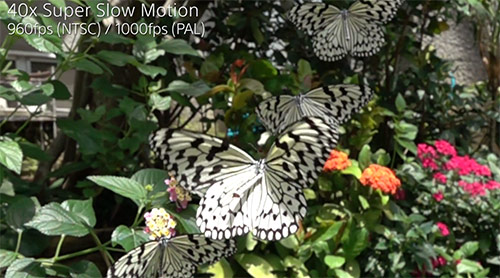
Pre Trigger Function:
“SONY: The end trigger mode also enables you to capture 2 or 4 seconds before the MOVIE button is pressed, letting you capture the decisive moment.”
It seems it has a pretty usable pre-trigger mode for slow motion. We estimate the recording of actual motion will be limited to a few seconds, which in slow motion HFR modes can be several minutes.
Newly developed Exmor RS 1″ Sensor:
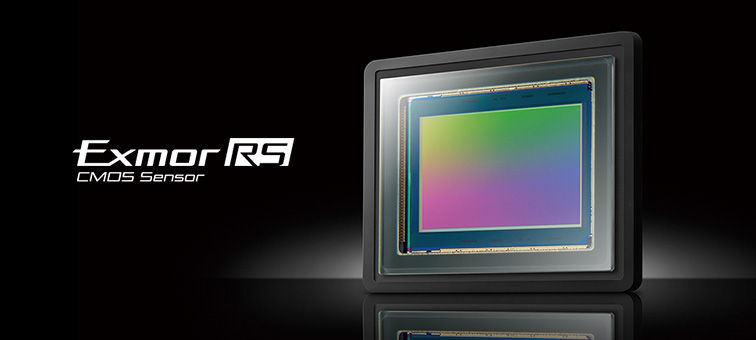
SONY: The world’s first 1.0-type stacked CMOS image sensor with DRAM chip enables up to 40x super slow motion and up to 1/32000 super-high-speed shutter beyond human perception. The extended circuit features higher signal processing capacity and more than five times faster high-speed readout than conventional models.
By making the circuit layer separate from the image sensor plane Sony has been able to dramatically increase eh sensor readout and maximum shutter speeds. This in turn makes these CMOS sensors almost as good as a Global shutter sensor but without the high noise drawback associated with the global shutter circuitry. There will still be rolling shutter present with these sensors as they are not exactly global shutters but the benefits are of far better high ISO performance and better image quality with a pretty substantial jump in read-out speed.
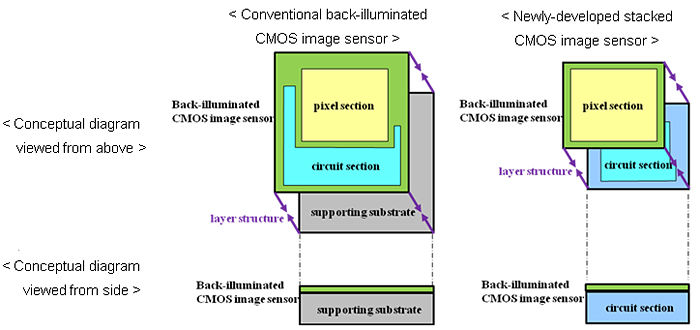
This is a huge development in sensor technology and we esteem that the new FS700 replacement will probably use a sensor that uses this impressive new sensor fabrication technology. You can read more about Stacked CMOS in this PDF by Sony!
What it means:
A few years back the HFR mode appeared on the Sony FS700 which is still #2 on our slow motion guide. These cameras inherit this technology with even what seems on the surface better specs regarding resolution as frame rate increases due to the new Stacked CMOS sensor tech. It will be a matter of looking at actual real world samples to see where they land in regards to quality compared to the FS700 and FS7. Be aware that these cameras record in XAVC S at 50 megabits which is great if the conversion is done properly. One thing is for sure, the low end slow motion game with higher quality frame rates has been altered forever by these offerings. Sony is serious about advancing technology and these cameras show how ahead of the game can they go when they strive for it.
Movie Slow Motion Samples for the RX Cameras:
The videos below will show you an idea of what the quality can be like, be sure to watch in 1080p to see the actual resolution. It is clear that more high end cameras like the edgertronic or upcoming fps1000 retain better image quality and resolution at higher frame rates. However these are very impressive for cameras under $1500 USD. All samples by SONY.
BMX Bike Sample Footage 40x – 960fps Slow motion:
Snowboarding 480fps 20x Slow Motion:
Insects 40x – 960fps Super Slow motion:
Children with bubbles 40x – 960fps Super Slow motion:
Water Balloon & Apple hit by Arrows 40x – 960fps Slow motion:
Pre-orders for each model will begin on June 17!
DSC-RX10 II Adorama Pre order Link Here Free Shipping $1,298!!!
&
DSC-RX100 IV Adorama Pre order Link Here Free Shipping $948!!!
Stay tuned for more on these cameras and more at HSC. Be sure to comment below or share this story to support us. Thank you!

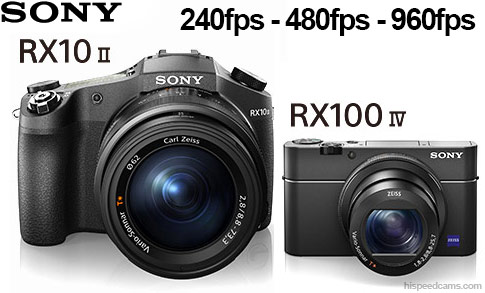
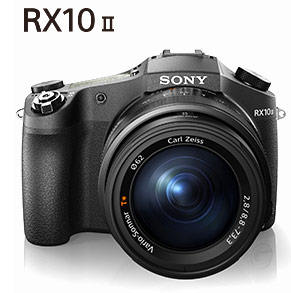
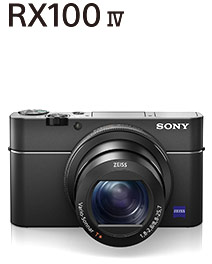
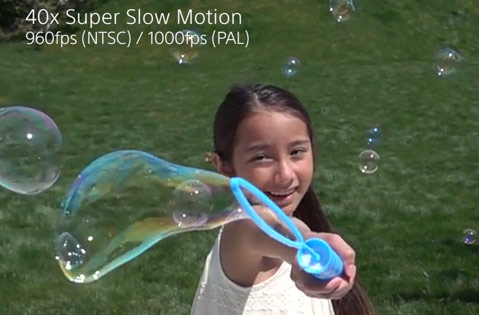
These cameras look nice, but they are not actually recording at the resolutions claimed. They are scaling to 1080p from a lower resolution in the high speed modes:
From Sony’s official site – Sensor Readout Number of effective pixels:
240fps/250fps (1,824×1,026),
480fps/500fps (1,676×566),
960fps/1000fps (1,136×384)
The 500fps mode looks pretty useful, but there is a lot of aliasing in the 1000fps mode.
Yes, which is why we pointed out the resolutions and the implications in the article. Did you miss them?
The FS700 records less than 1080p at 120 and 240fps and introduces some aliasing and moire too but the quality is acceptable. These cameras seem to produce even better resolutions at higher frame rates compared to that camera. Too early to tell but so far it is a big development in something so inexpensive.
The title of the article boasts “True HD” , followed by a huge listing of 1920×1080 slow motion capabilities for both PAL and NTSC. I may have missed it because I was excited to finally see a camera offering “1080p@1000fps” for an affordable price and I jumped from the specs right to the sample videos. An honest mistake. My apologies.
It does allow for true HD slow motion as HD is 1280*720 pixels. Full HD is 1080p which these cameras do shoot at up to 120fps. 240fps is very close to 1080p so it is quite a good spec.
As the article points out if you need no compromises you will need to step up to higher end cameras like the edgertronic or the upcoming fps1000 Platinum to retain better resolution. For many however aliasing and moire are secondary considerations when high frame rates are the main purchase decision. For many users what is offered in these cameras is nothing short of a giant leap forward especially in this price range.
As this sensor technology is adopted on higher end offerings by Sony it should allow for uncompromising quality at even higher frame rates. The technology used here is a big step forward for slow motion at a lower price point.
Thanks for your support!
Very awesome indeed! These are game changers in the low end high frame rate market.
Do you think both the models will shoot the same slow-mo video quality? I plan to get the RX100 IV for compactness and low light.
The reason I ask is because if you look at the 960 fps clip with the girl with bubbles, you will notice in the second clip with the dog running that it is noticeably better quality and has less aliasing than first and last clips of that same video. Is it just me? What do you think? I was wondering if the difference is between the camera models or between the shoot time priority and quality modes.
Too early to tell, the sensor and memory interface are the same and the Bionz processor also. The codecs are the same at 50 megabits. It will be a matter of testing once they are on the field. If I was in the market for it I would get the larger model just in case as it seems to have a larger buffer for pictures and the form factor is also prone to better handling. We’ll know more in a few weeks, for now it is a huge development for users who don’t mind aliasing and moire in their footage.
I see. It seems from the footage that the aliasing and moire seem to be better than the iPhone 6.
Yes there is aliasing and moire but it seems a bit better and more manageable than iphone 6. Some of the 960 fps clips look better than some in the same vid so hopefully it has to do with settings.
Will this ship July?
Yes it is better but its still there. You probably won’t get that at 120fps and very little at 240fps. Once we get to see samples of these modes we’ll post them. Exciting cameras for the features and price even when other more professional offers have little or no artifacts these should fill a niche.
It’s funny cause the ts3cine which was valued at $30,000 at one point has some pretty wierd aliasing and moire which is pretty bad value for a camera that price.
I have done tests with iphone 6 240 fps slowmotion footage with overcranking software to simulate faux 480 fps and 720 fps and it looks pretty clean in terms of movement excluding aliasing and moire in certain situations.
Can’t wait to try overcranking on the 250 fps clips which has better resolution on the RX100 IV.
True but the Aliasing and Moire problems are caused by having no low pass filter on the TS3 Cine camera and other cameras like the edgertronic suffer from the same issues. The sensor by being low resolution is prone to generate these artifacts and a low pass filter would soften the image too much. The 240fps Full HD mode on the Sonys should have very minor artifacting and as you point out would play well with twixtor or frame blending with a high enough shutter speed.
Speaking of shutter speed, it is pretty insane we can go up to 1/32,000 shutter on this thing. :)))
I will be getting the FPS 1000 Platinum as well. Waiting impatiently for the new update from Graham. The RX100 IV might actually ship first.
If you get the Sony, be sure to share some samples for evaluation. I’ll credit you fully! The fps1000 should have an update soon, we are getting an upgraded Platinum when it’s ready.
I sure will share some samples and even do comparisons with the iPhone 6. I plan to preorder first thing on Wednesday next week to get it as early as I can in July. Thank you.
I plan to preorder first thing on Wednesday next week to get it as early as I can in July. Thank you.
Great, looking forward to it.
I actually might just get the RX10 II. It should give me better bokeh at long end which should help mask aliasing backgrounds and foregrounds. You think I will get better bokeh with the RX 10 II?
The RX10 II is the better camera no doubt. The only pluson the other is extreme portability. Any lens with a long zoom will be lower quality than a short zoom considering they use the same high quality elements.
Many cameras have high speed video mode and have high frame rates. These cameras seem to have high resolution also but I don’t yet understand the processing discussed above, ‘aliasing’, etc. and what it would mean for the timing accuracy of the high speed video.
The shutter speed and resulting motion blur is very important for many applications of high speed video. Does this camera only have automatic exposure control in high speed video mode and is shutter speed therefore dependent on light level in some unknown way ? Does it have manual exposure control for setting shutter speed? I have seen very high speed shutter speed specs presented that apply to the cameras still picture mode or 30 fps video but not to the camera’s high speed video mode.
With high resolution and high frame rates viewing very high speed objects, the Jello Effect may be significant for some applications.
I see samples of the high speed video. As is often the case the velocities of the objects in the videos are unknown. Are there any videos of golf swings from the side view where the motion blur and the Jello Effect would be clearly displayed?
Camera specs & descriptions for high speed video applications should always present (and not obscure):
1) Shutter speed capability in high speed video mode
2) How the exposure is controlled in high speed video mode: automatic or manual exposure control.
3) Information on Global or Rolling Shutter, Jello Effect
4) Sample videos that are informative such as golf swings from the side. Water splash and other subjects with unknown object velocities, unknown exposure control, unknown lighting and unknown lighting conditions limit the value to non-technical applications. In other words, mainly these videos cannot be used to evaluate motion blur.
It is too early to tell but for shutter speeds in the 1/1000 it should be ok as this new sensor tech has distortion artifact compensation. As to how it performs in many settings it’s an unknown at this time.
We expect to see full manual ISO, shutter speed and Aperture in the high speedmode along with a tone curve or picture style selection. If distortion is a big issue for your use then stepping up to higher end equipment is warranted.
The alias8ng and moire come from line skipping and up sampling to the 1080p frame from a lower res. Most low cost high speed options do this trick but these cameras seem to do so at resolutions unheard-of in this price range before. We’ll knowmore as these cameras ship.
Will the RX10 mark 2 have the slow motion playback within the camera like the fs700? I would love to hook it up to an external monitor for preview,
We think it probably will have playback at 30p or 24p in camera. More will be known when it ships and gets into users hands.
It seems like all the HFR modes in Quality Priority are maxed out at 2 seconds each. Was hoping 240fps and 480fps would record longer in Quality Priority mode. Oh well just have to work around it.
It seems to be the case as in this info from Imaging resource which had a hands on with the actual camera:
“The RX10 Mark II can also capture very high frame rate, super slow motion video clips at up to 960fps (1,000fps for PAL)! However, you can only capture two seconds of video at a sensor readout resolution of 1136 x 384 or four seconds at 800 x 270 at that rate. That may not seem like much, but keep in mind capturing four seconds at 960fps with the selectable playback speed set to 24fps results in over 2.5 minutes of playback. Other high-speed frame rates are available, starting from 240fps at almost Full HD readout resolution (1824 x 1026), but are also limited to two or four seconds of recording. According to early info, these sensor readout resolutions seem to be upsampled to Full HD (1920 x 1080) before being saved, but we’re waiting for confirmation on that.”
2 or 4 seconds should be plenty for most slow motion shots, you will just have to be quick on the triggering not to miss it.
Yeah you are right. Would’ve been sweet though to get 4 seconds at Quality Priority and 8 seconds with Shoot Time Priority. Longer time would’ve been useful for bike or skateboard tricks. But I guess that is what my future FPS1000 will be used for.
This tech is new for Sony’s low end it will be just a generation or two for full HD at 1000fps at this pace. Also these cameras might Auto Focus while recording high speed which could be a feature ahead of other high speed cameras. For something like birds in flight it could be great.
It will be interesting too testing the 120 FPS Full HD quality from the Samsung NX1 and Sony RX10 II.